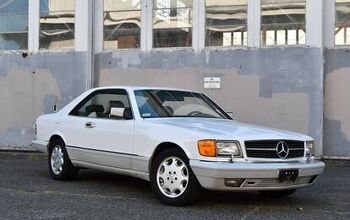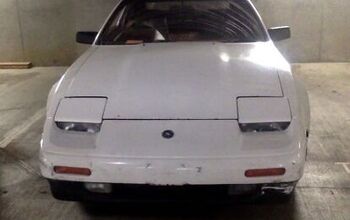Rare Rides: The 1992 Lotus Excel, End of an Era

Today’s Lotus Excel hails from the end of a period of transition at the famed British brand. Built for 11 years, by the end of Excel’s run the company had chosen a new direction for its cars.
Most would say the change was for the better.
The Excel entered production in 1982 in the form shown above, though its lineage traced back to the Seventies. Excel was a replacement for the Éclat coupe in production since 1975. Éclat was a sister car to the Elite shooting brake and was designed for people who wanted the sensibility and form factor of an actual trunk. Both cars were phased out when the Excel arrived.
These foundations are important because the new Excel was a rework of the Éclat it replaced. Fittingly its name at launch was Éclat Excel, which changed simply to Excel from 1984 onward. Penned by Peter Stevens of XJR-15 and McLaren F1 fame, the new, modern coupe was one of only two cars on offer from Lotus for 1982 alongside the Esprit. Both cars were a continuation of Lotus’ 1970s attempt to go more upscale and appeal to a different sort of buyer than they had with their lightweight, stripped-out cars.
Around the time the Excel was in development, Toyota bought lots of shares in Lotus, and enlisted Lotus engineers to help with development of their new sports car, the Supra. Part of the deal saw Toyota make parts available for use in Lotus vehicles, to which Lotus happily obliged. When the Éclat Excel debuted it used a Toyota five-speed, and the driveshafts, differential, wheels, and door handles from a Supra. The engine was Lotus, however, a 2.2-liter inline-four (160hp) from the Esprit. Excel’s body was made of plastic, in two halves that were joined together and mounted to a steel chassis. Engineers at Lotus were careful to give it a 50:50 weight distribution for driving enjoyment.
Over the years visual revisions were made to keep the Excel looking fresh. Several changes on the exterior occurred between ’84 and ’86 and included new wheels, hood, and front-wheel arches. 1986 also brought the more powerful S.E. performance variant, with a high compression version of the same 2.2-liter engine for 180 horsepower. There were more mechanical improvements in 1988 and even more visual changes in 1989.
But the changes didn’t help the Excel become a sales success. The company decided early on it wasn’t worthwhile to edit the Excel for American emissions compliance, and customers elsewhere were not very interested in an expensive Lotus coupe that wasn’t the Esprit. The Excel ended production in 1992, without replacement. In 11 years, just 2,075 Excels were built. The Esprit soldiered on as the famous car it was, and Lotus took a new approach with its other offerings. The Elan roadster introduced for 1989 signaled the brand’s return to lightness. From there, Lotus continued with smaller cars like the Elise, Exige, and Evora, and left its luxury aspirations in the past.
Today’s very clean Rare Ride is an S.E. trim in luxurious red over white. With 94,000 miles, it sold recently for $9,769 in England.
[Image: Lotus]

Interested in lots of cars and their various historical contexts. Started writing articles for TTAC in late 2016, when my first posts were QOTDs. From there I started a few new series like Rare Rides, Buy/Drive/Burn, Abandoned History, and most recently Rare Rides Icons. Operating from a home base in Cincinnati, Ohio, a relative auto journalist dead zone. Many of my articles are prompted by something I'll see on social media that sparks my interest and causes me to research. Finding articles and information from the early days of the internet and beyond that covers the little details lost to time: trim packages, color and wheel choices, interior fabrics. Beyond those, I'm fascinated by automotive industry experiments, both failures and successes. Lately I've taken an interest in AI, and generating "what if" type images for car models long dead. Reincarnating a modern Toyota Paseo, Lincoln Mark IX, or Isuzu Trooper through a text prompt is fun. Fun to post them on Twitter too, and watch people overreact. To that end, the social media I use most is Twitter, @CoreyLewis86. I also contribute pieces for Forbes Wheels and Forbes Home.
More by Corey Lewis
Latest Car Reviews
Read moreLatest Product Reviews
Read moreRecent Comments
- Bkojote Allright, actual person who knows trucks here, the article gets it a bit wrong.First off, the Maverick is not at all comparable to a Tacoma just because they're both Hybrids. Or lemme be blunt, the butch-est non-hybrid Maverick Tremor is suitable for 2/10 difficulty trails, a Trailhunter is for about 5/10 or maybe 6/10, just about the upper end of any stock vehicle you're buying from the factory. Aside from a Sasquatch Bronco or Rubicon Jeep Wrangler you're looking at something you're towing back if you want more capability (or perhaps something you /wish/ you were towing back.)Now, where the real world difference should play out is on the trail, where a lot of low speed crawling usually saps efficiency, especially when loaded to the gills. Real world MPG from a 4Runner is about 12-13mpg, So if this loaded-with-overlander-catalog Trailhunter is still pulling in the 20's - or even 18-19, that's a massive improvement.
- Lou_BC "That’s expensive for a midsize pickup" All of the "offroad" midsize trucks fall in that 65k USD range. The ZR2 is probably the cheapest ( without Bison option).
- Lou_BC There are a few in my town. They come out on sunny days. I'd rather spend $29k on a square body Chevy
- Lou_BC I had a 2010 Ford F150 and 2010 Toyota Sienna. The F150 went through 3 sets of brakes and Sienna 2 sets. Similar mileage and 10 year span.4 sets tires on F150. Truck needed a set of rear shocks and front axle seals. The solenoid in the T-case was replaced under warranty. I replaced a "blend door motor" on heater. Sienna needed a water pump and heater blower both on warranty. One TSB then recall on spare tire cable. Has a limp mode due to an engine sensor failure. At 11 years old I had to replace clutch pack in rear diff F150. My ZR2 diesel at 55,000 km. Needs new tires. Duratrac's worn and chewed up. Needed front end alignment (1st time ever on any truck I've owned).Rear brakes worn out. Left pads were to metal. Chevy rear brakes don't like offroad. Weird "inside out" dents in a few spots rear fenders. Typically GM can't really build an offroad truck issue. They won't warranty. Has fender-well liners. Tore off one rear shock protector. Was cheaper to order from GM warehouse through parts supplier than through Chevy dealer. Lots of squeaks and rattles. Infotainment has crashed a few times. Seat heater modual was on recall. One of those post sale retrofit.Local dealer is horrific. If my son can't service or repair it, I'll drive 120 km to the next town. 1st and last Chevy. Love the drivetrain and suspension. Fit and finish mediocre. Dealer sucks.
- MaintenanceCosts You expect everything on Amazon and eBay to be fake, but it's a shame to see fake stuff on Summit Racing. Glad they pulled it.


































Comments
Join the conversation
If Lotus had exported this car to the US, they could have doubled their volume at least. Based on what I read about them at the time, the Toyota parts made them more reliable and the restyling made them a little more practical than the Eclat/Elite. They did look a tad bland, but reviewers otherwise had nothing but good things to say about them. It's never been officially documented but it is believed that Lotus didn't just help out with the Supra. The Mark I MR2 also benefited from Lotus know-how. I do know driving one was a revelation after driving a third-gen Trans Am. Great handling without a punishing ride? A 7500-rpm redline and 28 mpg? So good I ended up owning two of them. Unfortunately they were a bit rust-prone, but if I can find a third without too many holes in it, I'd jump at it.
Wow